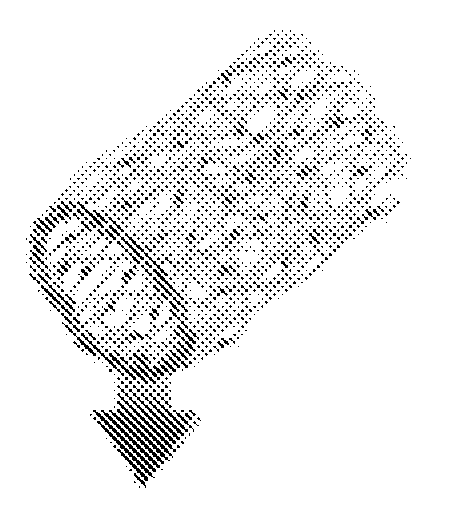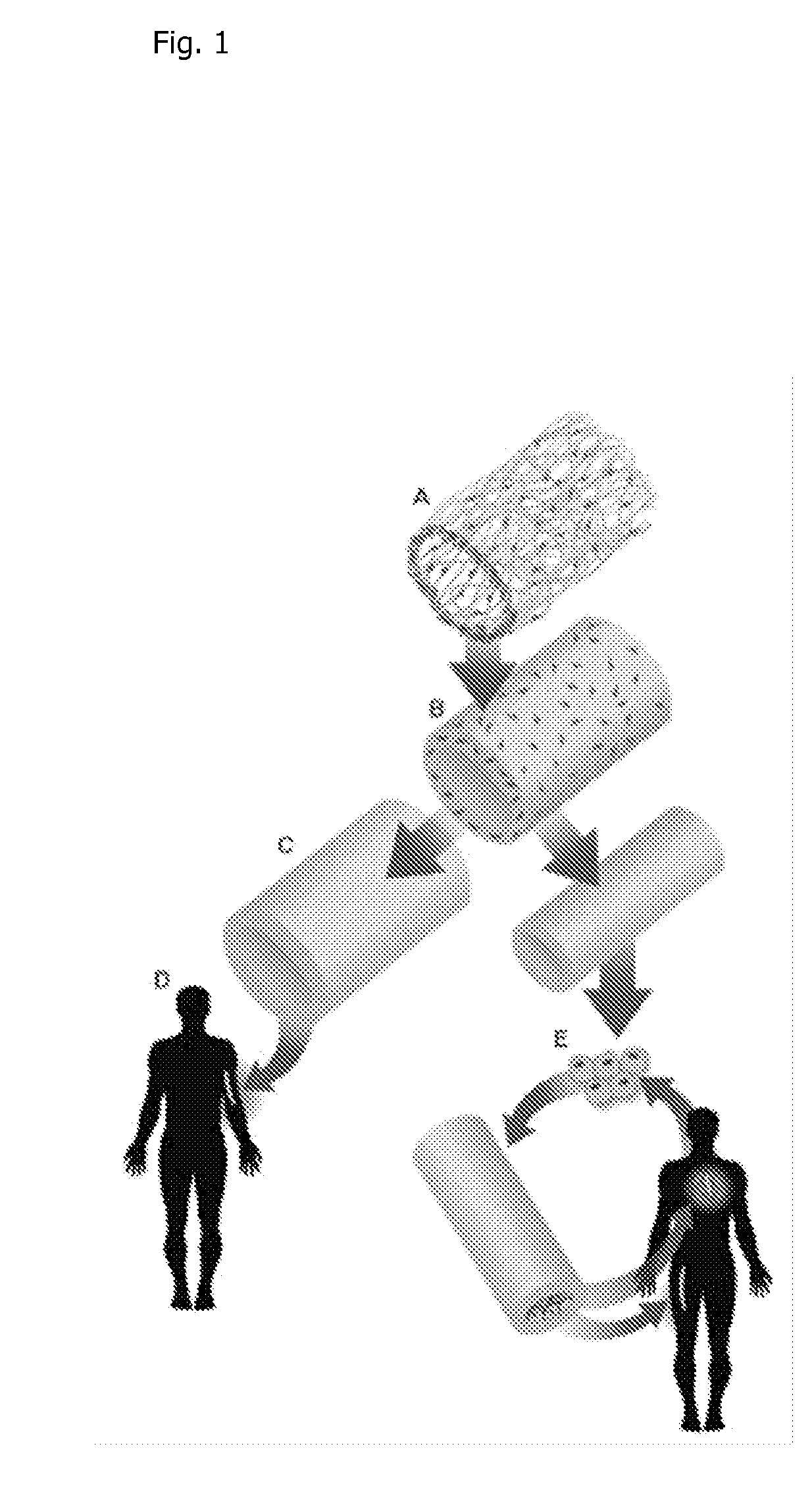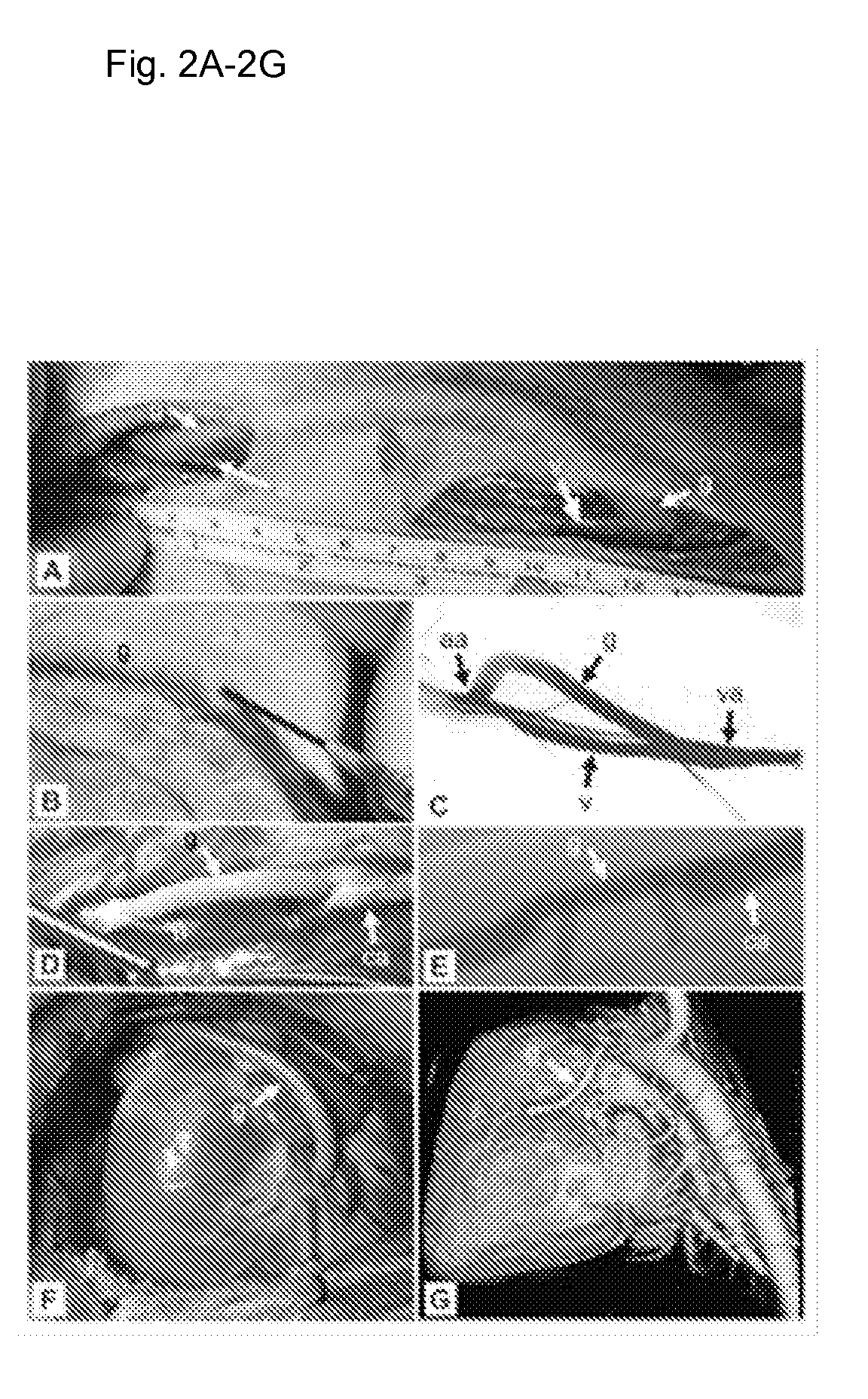Tissue-Engineered Constructs
a technology of tissue engineering and constructs, applied in the field of tissue engineering constructs, can solve the problems of poor median patency of hemodialysis ptfe grafts, approach will become standard clinical practice, and achieve the effect of increasing the rate of polyglycolic acid degradation and increasing the wettability of polyglycolic acid
- Summary
- Abstract
- Description
- Claims
- Application Information
AI Technical Summary
Benefits of technology
Problems solved by technology
Method used
Image
Examples
example 1
Formation of Polymeric Scaffold
[0134]Measure proper width and length of the PGA mesh (Polyglycolic acid felt) required and cut to size. For example, 3 mm-1.35 cm×desired length; 4 mm-1.66 cm×desired length; or 6 mm-2.35 cm×desired length. PGA Mesh can be obtained from Biomedical Structures (1 mm thick, 50 mg / cc (Range 45-58), 20×30 cm). Wrap mesh around appropriately sized silicone tubing cut 10 cm longer than length of mesh. Use felting needle to pull a fiber thread from one side of the mesh to the other side to entangle PGA fibers along the seam. Repeat all along seam edge. Entangle fibers tightly against silicone tubing to create a vessel / tubular shape of the mesh. Seam should be no thicker than the rest of the tube. The seam is then secured by mending any tears, holes or thin spots throughout mesh tube
[0135]The PGA is ideally 45-75 mg / cc. Low density (75 mg / cc) PGA is associated with a greater density of PGA residuals in the final product. FIG. 7a shows a uniform-density PGA fel...
example 2
[0153]All procedures were approved by their respective Animal Care and Use Committees, including Duke University, East Carolina University, and SyneCor. Animals received humane care according to the “Guide for the Care and Use of Laboratory Animals” (NIH, 1996). All surgeries and angiography were performed in sterile fashion under general anesthesia. After each surgery, graft patency was confirmed, wounds were closed, and animals were recovered. Animals were anti-coagulated with heparin (1000-5000 U) at implant. Baboons received aspirin (10 mg / kg), and dogs received dual anti-platelet therapy (325 mg aspirin / 75 mg clopidogrel), daily preoperatively until the end of the study.
[0154]Formation of Extracellular Matrix Protein Constructs:
[0155]Human aortas were obtained from an American Association of Tissue Banks (AATB) accredited and FDA registered tissue bank (CryoLife, Inc.), and met criteria for implantation (FDA 21CFR1271, AATB Standards for Tissue Banking, and internal C...
example 3
Generation of Extracellular Matrix Protein Constructs from Allogeneic Cells and Decellularization
[0186]To produce extracellular matrix protein constructs (3-6 mm in diameter), allogeneic smooth muscle cells (SMCs) obtained from cadaveric donors are cultured on rapidly degradable poly-glycolic acid (PGA) tubular scaffolds in a bioreactor that delivers cyclic radial strain (Niklason, et al., Science 284, 489-493 (1999)). During the culture period, SMCs secrete extracellular matrix proteins, predominantly collagen, to form biosynthetic vascular tissue (Niklason, et al., Science 284, 489-493 (1999)), and the PGA degrades. At the end of the culture period, the resultant tissue is decellularized with detergents, leaving only the secreted collagenous matrix (Dahl, et al., Cell Transplantation 12, 659-666 (2003)). The decellularization process kills cells, and removes antigenic, allogeneic cells from the construct, thereby allowing the use of banked allogeneic cells to produce extracellular...
PUM
| Property | Measurement | Unit |
|---|---|---|
| internal diameter | aaaaa | aaaaa |
| wall thickness | aaaaa | aaaaa |
| inner diameter | aaaaa | aaaaa |
Abstract
Description
Claims
Application Information
 Login to View More
Login to View More - R&D
- Intellectual Property
- Life Sciences
- Materials
- Tech Scout
- Unparalleled Data Quality
- Higher Quality Content
- 60% Fewer Hallucinations
Browse by: Latest US Patents, China's latest patents, Technical Efficacy Thesaurus, Application Domain, Technology Topic, Popular Technical Reports.
© 2025 PatSnap. All rights reserved.Legal|Privacy policy|Modern Slavery Act Transparency Statement|Sitemap|About US| Contact US: help@patsnap.com



